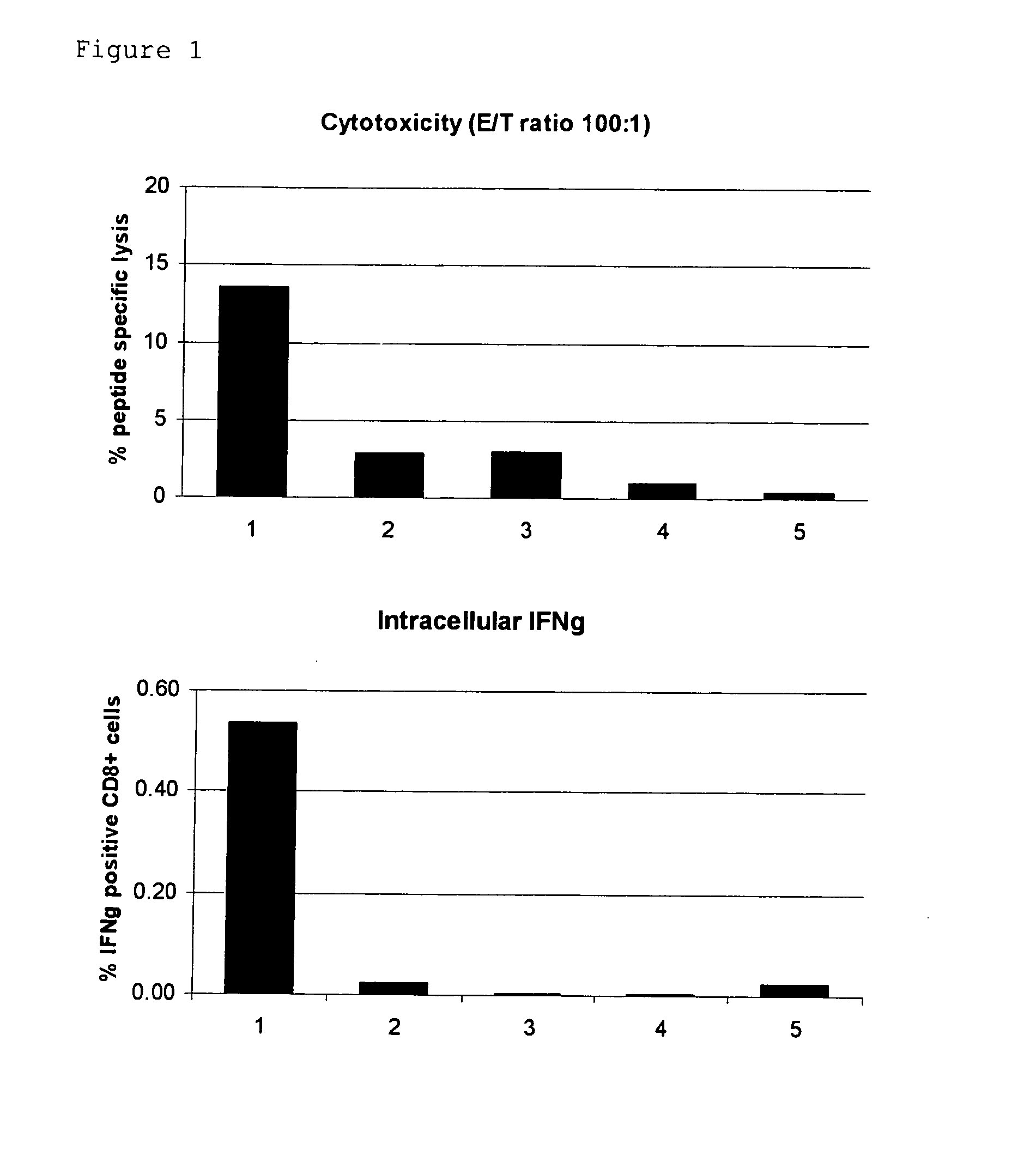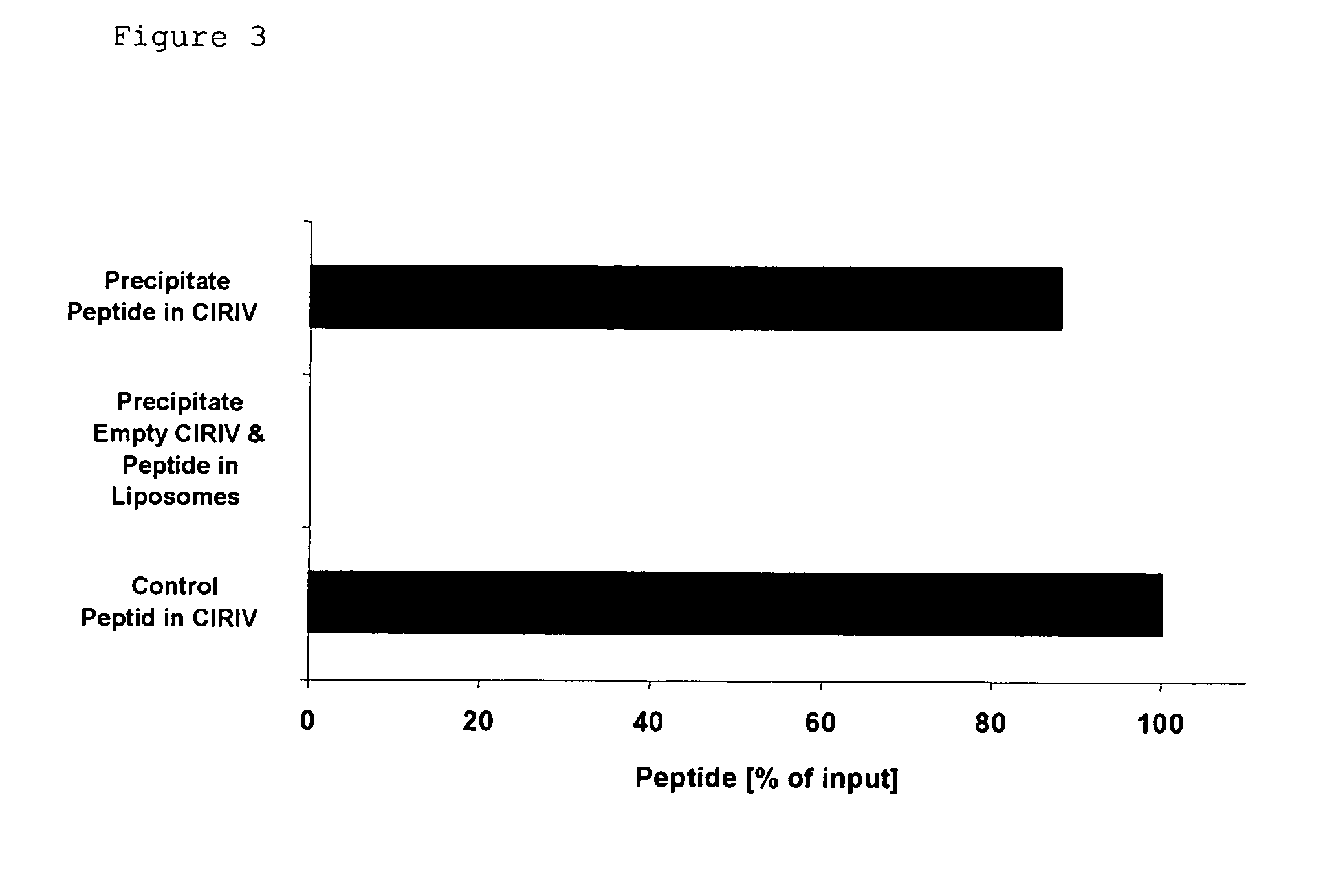Novel Trans-Adjuvant System
- Summary
- Abstract
- Description
- Claims
- Application Information
AI Technical Summary
Benefits of technology
Problems solved by technology
Method used
Image
Examples
example 1
[0132]Reagents and peptides: Octaethyleneglycol-mono-(n-dodecyl)ether (OEG, C12E8), 1,2-Dipalmitoyl-sn-glycero-3-phospho-rac-(1-glycerol) (PG), Mitomycin C, L-Glutamine, Penicillin, Streptomycin, Hepes, penicillin and RPMI medium are purchased from Fluka Chemie GmbH and Sigma (Buchs, Switzerland), respectively. Sucrose (Eur. Phar.) is purchased from Merck (Dietikon, Switzerland). FCS was purchased from Gibco BRL (Basel, Switzerland). Egg phosphatidyl choline (PC) is obtained from Lipoid (Cham, Switzerland). 1-Oleoyl-3-palmitoyl-rac-glycero-2-phosphoethanolamine (PE) and peptides are obtained from Bachem (Bubendorf, Switzerland). Bio-Beads SM2 are purchased from Bio-Rad Laboratories (Glattbrugg, Switzerland). Cr51 are obtained from Amersham Biosciences (Otelfingen, Switzerland). IL-2 is obtained from EuroCetus B.V. (Amsterdam, The Netherlands). N-succinimidyl-S-acetylthioacetate (SATA) is purchased from Pierce Biotechnology (Rockford, USA).
[0133]Influenza viruses of the A / Singapore / 6...
example 2
[0134]Preparation of the standard virosomes (IRIV): For a final volume of 4 ml, 32 mg egg PC and 8 mg PE are dissolved in 3 ml of PBS, 100 mM OEG (PBS / OEG). 2 mg HA of inactivated influenza A / Singapore / 6 / 86 virus is centrifuged at 100,000× g for 1 h at 4° C. and the pellet is dissolved in 1 ml of PBS / OEG. The detergent solubilised phospholipids and viruses are mixed and sonicated for 1 min. This mixture is centrifuged at 100,000×g for 1 h at 18° C. and the supernatant is sterile filtered (0.22 μm). Virosomes are then formed by detergent removal using 1.25 g of wet SM2 Bio-Beads (BioRad, Glattbrugg, Switzerland) for 1 h at room temperature with shaking and three times for 30 min with 0.625 g of Bio-Beads SM2 each.
[0135]Chimeric virosomes (CIRIV) containing HAs from X-31 and A / Sing were prepared similarly. Equal amounts of viral proteins from the two virus strains were mixed before solubilization.
example 3
[0136]Preparation of liposomes with encapsulated specific peptide: 36.4 μmol (28 mg) PC and 15.6 μmol (11 mg) PG (molar ratio 70:30) are dissolved in methanol / chloroform (2:1). The solvent is removed by a rotary evaporator (Rotavapor R-205, Büchi Labortechnik, Switzerland) at 40° C. at a gradual vacuum of 30-10 kPa. The dried lipid film is hydrated with 350 μl PBS containing 2-3.5 mg of the specific peptide to be encapsulated. Before extrusion, the volume is adjusted to 500 μl with PBS. The liposome dispersion is then extruded ten times through polycarbonate membranes (Nucleopore Track-Etch membrane, 0.2 μm, Whatman, Kent, UK) with a 1.5 ml Lipex Extruder (Northern Lipids, Vancouver, Canada). Size determination of extruded liposomes is done by light scattering using a Zetasizer 1000HS instrument (Malvern Instruments, Worcestershire, UK).
PUM
| Property | Measurement | Unit |
|---|---|---|
| Mass | aaaaa | aaaaa |
| Mass | aaaaa | aaaaa |
| Mass | aaaaa | aaaaa |
Abstract
Description
Claims
Application Information
 Login to View More
Login to View More - R&D
- Intellectual Property
- Life Sciences
- Materials
- Tech Scout
- Unparalleled Data Quality
- Higher Quality Content
- 60% Fewer Hallucinations
Browse by: Latest US Patents, China's latest patents, Technical Efficacy Thesaurus, Application Domain, Technology Topic, Popular Technical Reports.
© 2025 PatSnap. All rights reserved.Legal|Privacy policy|Modern Slavery Act Transparency Statement|Sitemap|About US| Contact US: help@patsnap.com



